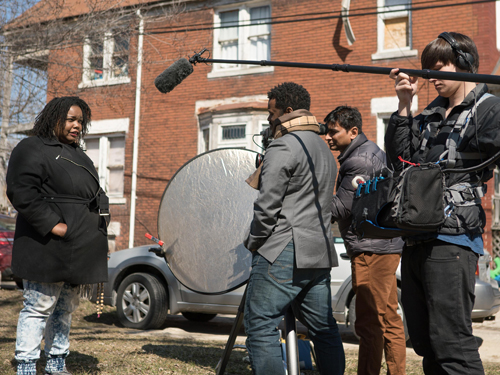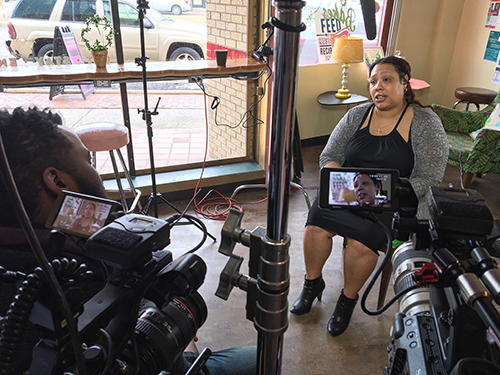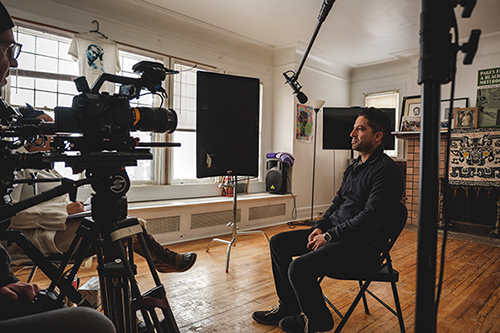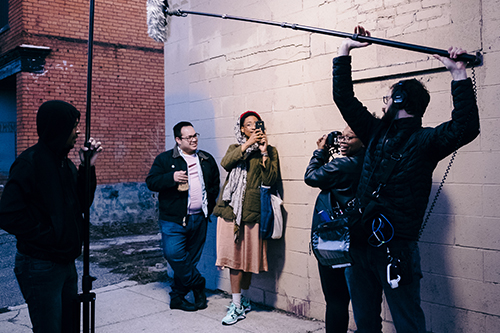When the Detroit Narrative Agency (DNA) issued a call for project proposals, they were seeking film projects that shift narratives about Detroit, particularly projects led by those most often excluded from critical conversations about the city: Black and Brown Detroiters. Two years later, five DNA projects are in production and slated to present work-in-progress screenings at the 20th Annual Allied Media Conference in June.
The DNA project creators move with a sense of dedication to community and purpose beyond filmmaking. They are Detroiters, most of whom are first time filmmakers, directly impacted by the subject matter of their films. This creates a unique relationship that enables an individual project to become a community collaboration at its core.
Femme Queen Chronicles
Femme Queen Chronicles, a narrative web series directed by Ahya Simone and produced by Paige Wood and Cierra Malone, centers on the friendship between four trans women on different paths. While Femme Queen Chronicles showcases trans women in authentic space, it is also contending with cis-hetero narratives about Detroit that have led to the erasure of a rich Black Trans & LGBTQ history deemed unworthy of being archived, preserved, or uplifted. As Ahya says, “trans folks been here” but have been rendered invisible in narratives about Detroit.
Beyond having a brilliant and hilarious cast, Femme Queen Chronicles has also implemented an impact strategy that includes a crew that consists of mostly trans women of color working behind the scenes, learning from film professionals. This strategy is Ahya’s way of “honoring talent within the community” while sparking interest in film production. It contends with historical erasure, as she puts it, by “exploring the lives and experiences of trans women in Detroit through four distinct characters which, to my knowledge has never been done before. In the future, we are trying to create more sustainable opportunities for folks.” Additionally, Ahya explains, “it was important to me that this was a community effort not just a ‘me’ thing. And it was important that we not only continue to critique, but also build what I want to see. I’m thankful for the opportunity to do so.”
Listening to the cast and some of the crew cracking inside jokes and shaping their characters gives the sense that this project is about the community of folks who trust in the vision of bringing positive, complex, trans characters to audiences.
Take Me Home
While narratives of Detroit celebrate the so-called ‘rebirth’ of the city with white corporate giants as its protagonists, longtime Black and Brown Detroiters are being pushed out and cast aside in that process. Take Me Home, a documentary short project directed by Orlando Ford and produced by John Sloan, focuses on the foreclosure crisis in Detroit. This project seeks to shift narratives about Detroit’s rebirth – which is only reflected in 7.2 square miles of the 139 square mile city – by centering individuals who have been displaced from their homes due to illegal foreclosures and evictions.
While foreclosure is often a humiliating process, Take Me Home makes legible the root causes of the crisis in an accessible and humanistic way. In one narrative, for instance, one of the film’s subjects spoke about making her house look junkier from the outside so that someone coming from the outside would not attempt to buy it. Orlando comments, “no other city is seeing this kind of displacement except after facing a natural disaster.” Oftentimes, blame is placed on the individuals facing foreclosure without consideration for the governmental and institutional drive to create a heightened real estate market via displacement.
From Orlando’s perspective, “our hope is that by giving residents a platform to speak out about illegal tax foreclosure,” it will “bring light to a subject that for most people is a taboo subject, their finances. No one really discusses this subject, not even to their own family, let alone their neighbors. And the shame often hides a more systemic problem that we can only tackle as a collective.” He adds, “by bringing awareness we feel that knowing that you’re not really alone in this fight, it also brings strength to the cause, and increases the number of citizens who can rally and demand action by our elected officials. By screening at as many public venues as possible, we hope to get the word out so that citizens can fight this. And demand more action from city government.” Their impact strategy includes screenings in public libraries around the city as sites to have conversations about collectively pushing back against illegal tax foreclosure.
Sidelots
Sidelots is also a documentary exploration contending with the structural obstacles to Black land ownership in Detroit, which started as one family’s attempt to acquire a side lot. Director Atieno Nyar Kasagam and producer Natasha Tamate Weiss are developing this project, which began as an attempt to expose corruption in Detroit’s Land Bank system.
Sidelots began to take shape when Atieno and her husband Lorenzo sought to acquire one of the vacant side lots adjacent to their home on the Eastside of Detroit. Atieno’s goal for the project is to make viewers put aside any associations between poverty and agriculture and to highlight the ways in which “land is a universal language and a universal pleasure.”
While making this film, the family suffered the loss of twins, which, as Atieno explains, “radically changed how we saw ourselves in relationship to the land, and we began to transform the language from being urban farmers to a language of reconnecting to our lineages, our dead, our ancestors.” The connection of land and burial is tangible for Atieno. “In practice, we were forced to deal with the remains of our children and not knowing what to do with them or where to take them. And because of the law, because of the unpredictability of ownership of land in Detroit, we began a pilgrimage down south to Alabama to Lorenzo’s ancestral land, and we spontaneously offered our twins’ ashes to the land there.”
While that brought the family some peace, they were still not satisfied, which led to a journey to her family land in Kenya with the twins’ ashes. “My family received them so majestically,” Atieno recalls. “They were honored like they were full grown babies, buried in huge coffins that cost a lot of money” which Atieno never anticipated. “You learn how important burial is,” she explained, “and burial on land that is sacred to family. And all of these things have compelled us to expand the argument, the story, of our land in Detroit. This land is and should be sacred for us here in the city.”
Land is, in many ways, the lead character of Sidelots, and it will compel viewers to make space for the radical perspective that Black people deserve land to sustain their communities in Detroit. As Atieno puts it, “the fight for land is not just about fight for space to grow fruit to take to the eastern market or vegetables, it’s about sacred connections that will endure over generations.” The intended impact of this project is to make it easier and more appealing for Black Detroiters to acquire side lots regardless of the city’s red tape and resistance to change, and also drawing out conversations about these sacred connections. In Atieno’s words, “one of the easiest and most powerful examples that is a practice of burying and the rituals around death, and so that’s why the film is intersecting rituals of burial and death with the movement around land.”
Dangerous Times: Rebellious Responses
Dangerous Times: Rebellious Responses is directed by Alicia Diaz and produced by Consuela Lopez. This documentary project about the sanctuary movement in Detroit focuses on Alicia’s sister Esther who engaged with struggles around sanctuary. Alicia describes Esther’s journey as being at odds with the broader movement. “By the time the proverbial knock came to her door in the late 1980’s,” Alicia explains, “Esther had rejected a number of political ‘isms’ and was focused on her neighborhood and family. I think this is why it was inevitable that she would come into conflict with the structure of the movement, and was imprisoned in El Salvador for her activism.”
Esther was one of the only Latinx Detroiters active in the largely white-led movement during that time, and endured unimaginable violence and trauma. Alicia explains her sister’s resilience by using one of Esther’s favorite sayings: “there is a difference between being conquered and defeated.” She elaborates that for Esther, “the sexual violence unleashed upon her was a defeat of her physical person, but she refused to allow her jailer/rapist to conquer the person she was. While it may sound incredulous to many, her spirituality cemented her resolve that she would not die in that prison.” By not allowing her imprisonment to continue happening in her memory, Esther was able to move forward and focus her energy.
The film goes beyond Esther’s story to investigate the historic legacy of Detroit as a sanctuary city, from the Underground Railroad to the present moment, and centers the activism of Latinx people. In their impact strategy, Dangerous Times has partnered with undocumented and DACAmented youth who are both working on the film and shadowing the crew. “Esther has long discussed that the primary motivation for her is that the voices of those in Sanctuary be heard as opposed to the movement leadership,” Alicia explains. “Once she learned of the involvement of young people in the project, she became doubly motivated by the opportunity for her lessons learned to make a difference for those on the front lines today, and to perhaps lend to her own continuing healing.”
Both the film and impact strategy are doing the work of shifting narratives about Detroit and about the sanctuary movement itself by putting multiple generations of Latinx Detroiters at the forefront of the story and behind the scenes.
Riding With Aunt D. Dot
Like Sidelots, Riding With Aunt D. Dot evokes a sense of sublime magic in underexplored spaces in the city. Directed by and starring Bree Gant, Riding With Aunt D. Dot takes an experimental approach to real world experiences with keen attention to fashion and the realities of using public transit in the Motor City. As Bree says, public transit riders in Detroit are “a forgotten people in a forgotten city.”
This film, a narrative short about a bus riding artist in Detroit, transports viewers from a seemingly typical bus ride into a realm filled with magical realism and luminous color. The film visually depicts the rich interior lives of bus riders with this transition from the average to the extraordinary and strange. With producer Paige Wood and a cast and crew of ten collaborators, this project seeks to create space for transit riders to exist as they are. “As a transit rider, I’m looking for a perception shift,” Bree explains, “where drivers stop saying things like ‘oh no, what happened?’ to essential transit riders.”
There may be “new bus red carpets on Cass” but “more benches are a must” and she hopes to see murals and art installations at bus stops without “riders being displaced for construction that has nothing to do with us.” To this end, Riding With Aunt D. Dot has partnered with the Transit Justice Team of Detroit People’s Platform with the goal of showcasing the stories of people most Detroiters drive by every day without noticing. Together, they are planning an art installation of transit rider portraits in public spaces paired with their stories. By developing public spaces for transit riders to tell their stories, Riding With Aunt D. Dot seeks to uplift transit riders’ visibility in real time in the same ways that the film does.
Future Plans
Overall, each of DNA’s five projects is carrying out the mission of shifting Detroit narratives through stories told by marginalized Detroiters. As a cohort, they run a wide range of lived experiences and narrative aesthetics, with a common goal of uplifting voices and circumstances that have been left out of conversations about Detroit’s history and “comeback.” In the coming months, they will screen their works in progress at the Allied Media Conference, and launch their impact campaigns. Additionally, they will begin the process of film distribution and screenings, so look out for more details on how to see these powerful films.
Each of these projects makes clear that Detroit never went anywhere, the lives and concerns of its inhabitants have simply been ignored and undervalued by outsiders and policymakers. These five projects make change seem not only possible, but tangible on the horizon.
Don’t miss the screening! View the full schedule of workshops, screenings, and meetups taking place as part of DNA’s Shaping Stories, Shifting Power track at the 20th annual Allied Media Conference.









